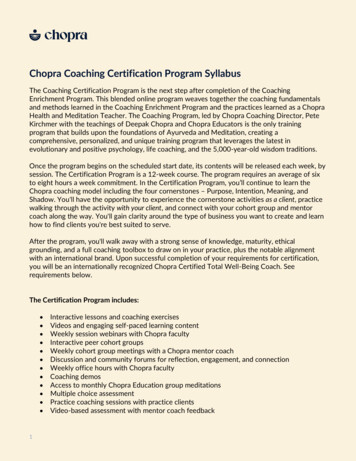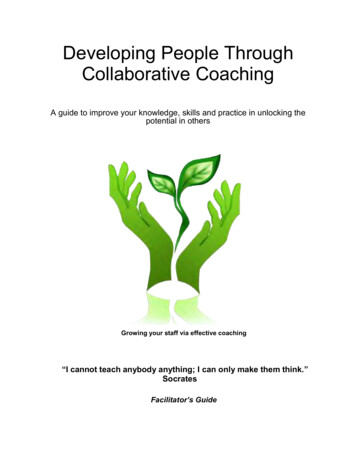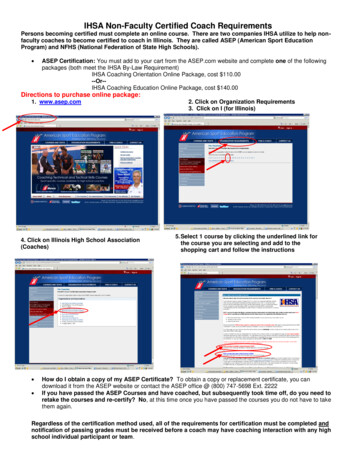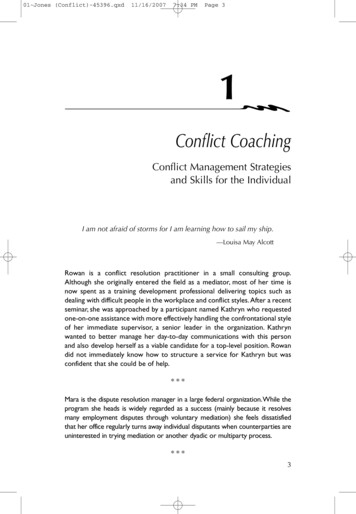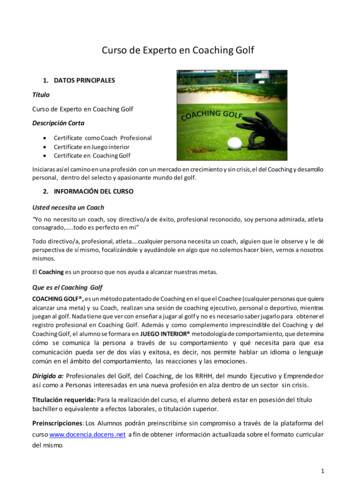
Transcription
Chapter 1: Introduction toCoachingConfidentialPage 1 of 525/1/2009
AcknowledgementsThis manual represents the culmination of almost nine years of work bymany colleagues and collaborators. We can’t go further without firstacknowledging the shoulders on which we stand.Coaching started in sports as games developed with ever morecomplicated rules and performance expectations. Coaches emergedwho taught the game, structured training, gave feedback, and otherwiseassisted people to do better. In the early 1970s, a young tennis coachnamed W. Timothy Gallwey wrote an extremely influential book, TheInner Game of Tennis (1974), which transformed the art of sportscoaching with its revolutionary approach to coaching and humanperformance improvement. After Gallwey it wasn’t enough to teach thegame and give feedback; coaching had as much to do with assistingpeople to get out of their own way (the inner game) as with themechanics of the outer game. With that insight, the modern coachingmovement was born.Since that time, there has been a virtual explosion of books and trainingon the principles and practices of coaching. It seems there is no end towhere people will go with the science of facilitated human learning.Today more than 30,000 coaches have pursued coach training andserve a 1.5 billion market – mostly executive/corporate and lifecoaching.We are particularly moved by the vision of Tony Grant, PhD, the firstcoaching psychologist who founded the Coaching Psychology Unit atConfidentialPage 2 of 525/1/2009
the University of Sydney in 2000. His work inspired us to be boldenough to call this manual a coaching psychology manual.As we’ve developed our coach training curriculum we’ve been blessedby the early and unwavering support and endorsement of the AmericanCollege of Sports Medicine, particularly Walt Thompson, PhD, and JimWhitehead, whose partnership we sought to keep us on target in aimingfor the highest possible standards.The first iteration of this manual was developed from 2000–2002 byMargaret Moore, MBA, in collaboration with Steven Jonas, MD; GabeHighstein, PhD; Juli Compton, PhD; Sheryl Marks Brown, BA; KateLarsen, BS; Joan Price, MA; and Tony Rodriguez. Importantcontributions from others followed quickly, including Walter Thompson,PhD; Robert Rhode, PhD; Lori Gray Boothroyd, PhD; Pam Schmid, BS;and Jessica Wolfson, BS. Gloria Silverio, MA, led a complete editing ofthe manual in 2006 as well as bringing significant and new content.Carol Kauffman, PhD, Gloria Silverio, and Jessica Wolfson helped usintegrate important tenets of positive psychology throughout the manual.The LifeTrek Coaching team, led by Bob Tschannen-Moran, MDiv, andErika Jackson, MA, spearheaded an enormous effort in 2006 and 2007to expand the curriculum by further integrating tenets of positivepsychology, strengths-based change strategies, nonviolentcommunication, and relational flow (the intuitive dance of coaching).They also spearheaded the effort to structure the curriculum in accordwith adult learning theory and to align the curriculum with our ACSM-ConfidentialPage 3 of 525/1/2009
endorsed coach certification, creating wonderful checklists and guidesthat are incorporated into this manual.The team which developed a theoretical model for relational flow – theintuitive dance of coaching – brought important background to supportour coaching model, including Margaret Moore, David Drake, PhD, BobTschannen-Moran, Francine Campone, PhD, and Carol Kauffman, PhD.Carol and Margaret developed the material which is the foundation for anew chapter called Coaching Presence which teaches the being skills ofcoaching.The final draft of this manual was reworked in 2007 and 2008 by BobTschannen-Moran and Margaret Moore. We would not have completedthe manual without the tireless efforts of the Wellcoaches operationsteam to support all of us, led by the indefatigable and one-of-a-kind JeffCramer.We want to acknowledge all of the Wellcoaches faculty members whoalso serve as mentor coaches, including Blaine Wilson, MS, ChristinaLombardo Ray, MA, and Michael Scholtz, MS, for their dedication toteaching and mentoring coaches to master coaching competencies andfor calling us to continually refine the manual.Most importantly, our coach trainees have contributed substantively tothe evolution and presentation of coaching skills and processes. Theyhave challenged us to make them elegantly simple to practice and use.In fact, Chuck Schroeder, MS, nuclear engineer and now executiveConfidentialPage 4 of 525/1/2009
wellness coach, even created a streamlined version of a sample wellbeing assessment.All of us enjoy using these principles and practices every day to supportboth our own and our clients’ health and well-being. Not only have weall undergone personal transformations, we are incredibly fortunate tobe partners in the small and large transformations that our clientsexperience. It’s rewarding beyond compare. Coaching is our future.Margaret Moore, BS, MBAFounder and CEOWellcoaches CorporationBob Tschannen-Moran, MDiv, IAC-CC, CWCWellcoaches FacultyPresident, LifeTrek Coaching InternationalConfidentialPage 5 of 525/1/2009
Chapter 1Introduction to Coaching“I saw an angel in the stone and carved to set it free.”— MichelangeloChapter Contributors: Margaret Moore, Bob Tschannen-Moran,Gloria Silverio, and Lori Gray BoothroydWelcome to the Wellcoaches Coaching Psychology Manual. Thismanual is designed to teach basic coaching skills and processes. Whenwe use the term “coach” throughout the manual, we are referring tohealth coaches, fitness coaches, and wellness coaches.After reading this chapter, you will be able to: Distinguish between wellness, health, and fitness coaches Distinguish among business, life, wellness, fitness, and healthcoaching Define why we need professional coaches in physical and mentalwellness Distinguish between coaching and the expert approach of healthand fitness professionals Define coaching and identify the value of the coach/clientpartnership.ConfidentialPage 6 of 525/1/2009
Understand the key components of coaching psychology Describe the Wellcoaches process of coaching Distinguish between coaching and therapy Outline a Professional Coach Code of Ethics Define Liability and Scope of Practice guidelinesWhat Is Coaching?Coaching is, to quote W. Timothy Gallwey, “the art of creating anenvironment, through conversation and a way of being, that facilitatesthe process by which a person can move toward desired goals in afulfilling manner” (2000, p. 177). When those goals have to do withhealth, fitness and wellness, coaching becomes a vehicle for assistingpeople to achieve a higher level of both physical and mental well-being.In order to create such an environment, coaches use evocative morethan didactic approaches with clients. We do more listening than talking,more asking then telling, and more reflecting than commenting.Coaching is not mainly advising clients on how to solve problems, noreducating clients about what they should do, nor analyzing the rootcauses of client predicaments. Although advising, educating, oranalyzing problems are on occasion a part of coaching, they are neitherthe primary purpose nor approach of coaching.Coaches are collaborative and co-creative partners in clients’ journeysto reach their visions and goals.ConfidentialPage 7 of 525/1/2009
Distinguishing Among Wellness, Health, and Fitness CoachesWellcoaches has clarified the scope of three coach types in the health,fitness, and wellness arena.Wellness coaches are credentialed health, fitness, and mental healthprofessionals (including personal trainers, cardiac rehabilitationspecialists, dietitians, health educators, physical therapists, nurses,physicians, and behavioral health therapists) who coach clients onevidence-based areas of wellness or well-being – physical activity,nutrition, weight, stress, and life satisfaction. While wellness coachinghas a broad scope, coaches provide expert guidance and advice, whencalled for and where clients lack expert knowledge, only in the areaswhere they have professional credentials.Health coaches are credentialed healthcare professionals (includingnurses, nurse practitioners, physician assistants, clinical exercisephysiologists, and physicians) who combine coaching with their expertknowledge to assist their patients and clients to manage medicalconditions such as heart disease, diabetes, arthritis, and cancer.Fitness coaches are credentialed exercise professionals includingcardiac rehabilitation specialists, exercise physiologists, certifiedpersonal trainers, or group exercise instructors, who use coaching skillsto enhance personal training and fitness instruction outcomes. Fitnesscoaches wear both the training and coaching hats, in order to helpclients fully develop healthy lifestyles outside of exercise sessions.ConfidentialPage 8 of 525/1/2009
Distinguishing Among Business, Life, Wellness, Health, and FitnessCoachesCoaches today are becoming highly specialized in their areas ofexpertise. Corporations may hire executive coaches or businesscoaches to improve the performance of their executives or managers.Individuals may hire life coaches to navigate their way through a lifetransition (e.g., career changes or retirement) or to improve their qualityof life, management of time, or sense of life passion and purpose. Thereis no limit to the diverse niches and specialties that coaches offer.Although some life coaches offer health or wellness coaching, theirperspective is often centered more on aligning personal goals andvalues with improving well -being, rather than on motivating anddesigning health-promoting, evidence-based mental and physicalbehaviors in the areas of fitness, nutrition, weight management, healthrisk, stress management, and life satisfaction. Wellness, health, andfitness coaches assist clients to connect the dots between who they are,who they want to be, and, to take the incremental behavioral steps thatwill enable them to succeed in their desired changes leading to a higherlevel of health and well-being. Our coaching drills down to gritty basicseven as it aspires to great heights.Since coaching psychology principles are relevant to all forms ofcoaching, including wellness, health, and fitness as well as businessand life coaching, throughout the remainder of this manual the word“coach” will be used inclusively. It’s all about assisting clients to “movetoward desired goals in a fulfilling manner” (2000, p.177).ConfidentialPage 9 of 525/1/2009
Why We All Need CoachingEven though this manual was written for coaches working with clients,we all share the need for partners on the journey if we hope to behealthy and well. Even coaches need coaches in order to be our bestselves.While most of us long for better physical and mental well-being,considerable evidence suggests that we’re moving in the oppositedirection. Consider the paradox. Despite continuous media attentiondevoted to healthy lifestyles, there are now more overweight peoplethan undernourished people worldwide (WHO Fact Sheet, 2006). Thesituation in the US is particularly serious. A recent study shows thatAmericans are significantly less healthy and more overweight than Britsat the same age and socioeconomic level (Banks, et.al., 2006).Why do we have this paradox? While obesity is a multifactorial problem,at least four factors lead us to unwisely choose quick fixes that don’tlast, and this jeopardizes our confidence – what psychologists refer toas self-efficacy (Bandura,1997). First, there are the demands ofeveryday life, which have never been greater. Second, we face abewildering array of wellness guidelines, products, and services, makingit difficult to create a personal formula. Third, there is the challenge ofnavigating the inevitable obstacles to making changes, includingconfusion, resistance, and ambivalence. Fourth, many of us havehistories of repeated failure. Most of us do not believe that we canmaster our weight and wellness.ConfidentialPage 10 of 525/1/2009
We want to be well. We yearn to be in control of our health and to feelbetter. We want more energy. But there is an enormous gap betweenwanting to be well and the everyday reality of living with the physicaland mental health consequences of overeating, under-exercising, andhaving too little down-time to recharge our batteries.The evidence is indisputable. Being fit, strong, and having a healthylevel of body fat are safe and effective breakthrough medicines whichhelp prevent and treat almost every affliction studied, including mentalhealth. A quote from Tal David Ben-Shahar, Professor of PositivePsychology at Harvard University, is notable: “not exercising is adepressant.”Coping well with stress and increasing life satisfaction (e.g., a sense ofpurpose, gratitude, and meaning) are joining exercise and eating well as“lifestyle medicines.” Two thirds of healthcare costs are driven by ourdaily choices (Institute of Medicine, 2006) – we are in the driver’s seat.But knowledge is not enough. Only one in twenty adults engage in all ofthe top-six health behaviors (Berrigan, 2003): regular exercise, healthfulfat intake, at least five servings of fruits and vegetables daily, limiteddrinking, non-smoking, and maintaining a healthy weight.Getting people to optimal wellness is at the forefront of today’s hopesand dreams of physical and mental health professionals. This is the firsttime in human history where being in control of one’s health and makinghealth investments day in and day out are poised to be dominantConfidentialPage 11 of 525/1/2009
societal themes, just as smoking cessation was two decades ago, orsacrificing for the greater good was during World Wars I and II.We need to learn a new life skill – developing a personal blueprint forwell-being and becoming confident in our ability to implement it. Most ofus don’t believe we are able to master this life skill; the increasingnumbers of those who choose bariatric surgery represent the face of ourgreatest doubts (Elfhag & Rössner, 2005).The health and fitness industry has been working hard to help us. Neverbefore have there been more experts, assessments, resources,guidelines, technology, books, web tools, and beautiful high-techfacilities. The wellness revolution is underway (Rochaska, et. al.,1994),with a welcome new emphasis on enabling long-term behavior changeor “changing for good” (Pilzer, 2002). New interventions focus onassessing readiness to change for each health behavior, and thentailoring interventions and education to match readiness.While all of these resources are valuable, we need more. We normallyask experts to tell us what to do, and this approach isn’t ideal when wehave low self-efficacy (Joos & Hickam, 1990). Experts are trained todeliver prescriptions and advice, and often work harder than we do intrying to help us. But the expert approach actually lets us off of thehook, sending the subtle message: You aren’t in charge.The expert approach is vital when we are facing an immediate healthcrisis or considering surgery. It is not ideal when we want to lose weight,reduce stress, or develop a positive and confident mindset. DelegatingConfidentialPage 12 of 525/1/2009
to experts comes with a price: we are not in control and we aren’t askedto work to find our own answers. Building confidence requires newpatterns of thinking, doing, and relating.We also need a shift in emphasis to our strengths and opportunities,building on what’s working in our lives, and away from an emphasis ondiagnosing and fixing what’s not working. The more we focus on thelatter, the more we undermine self-confidence. It makes it harder, noteasier, to change when we focus on what’s wrong and what’s notworking. Not enough positive energy and emotion are harvested to fuelthe pursuit of change.Moreover, we need to take a holistic view of health and well-being.Specialists who work in only one area, such as exercise, nutrition, ormental health, without knowledge of or reference to the others aredestined to have limited effectiveness or even to cause harm. Theseareas are intrinsically intertwined and are most successfully dealt withall together. Most people need assistance to integrate information frommultiple experts in order to decide what actions to take and how toprioritize them. People find it confusing when experts contradict eachother. It is certainly not a recipe for promoting the “I can do it!” attitude.There are two other important things we need. First, without a heartfelthigher purpose, there is rarely deep and lasting change – we need toconnect wellness, health, and fitness to what we value most. Second,we need to develop a wellness, health, and fitness behavioral plan thatis personally tailored to our circumstances and capacities.ConfidentialPage 13 of 525/1/2009
Professional coaches have long been recognized for their skills inhelping athletes, sports teams, and executives perform at their best.Now, professional coaches are assisting clients to make lastingimprovements in their health and well being.The emerging professions of wellness, health, and fitness coaches aredesigned to enable people to be done with quick fixes, to overcometheir challenges, to master health and well being, and to make changesthat last.With a focus on building self-efficacy, professional coaches are trainedto: accept and meet us where we are today; ask us to take charge; guide us in doing the mindful thinking, feeling, and doing workthat builds confidence; help us define a higher purpose for health and well-being; uncover our natural impulse to be well; help us tap into our innate fighting spirit; address mental and physical health together; assist us to draw a personal wellness, health, or fitness blueprint; help us to set and achieve realistic goals (small victories lay thefoundation for self-efficacy); harness the strengths we need to overcome our obstacles; reframe obstacles as opportunities to learn and grow; enable us to build a support team; and inspire and challenge us to go beyond what we would do alone.ConfidentialPage 14 of 525/1/2009
What Coaching Isn’t –The Expert ApproachCoaching is an especially powerful methodology when it comes tostimulating individual behavior change because it is focused on helpingclients grow into becoming the experts of their own well-being. Coachesdo not show up as experts who primarily: analyze problems, give advice, prescribe solutions, recommend goals, develop strategies, teach new skills, or provide education.Although such expert approaches are appropriate in a coachingrelationship, they are used “just in time,” and only rarely as needed. Inthe coach approach, the client is called to become the decision-makerand grow into the expert on the path forward as well as the final judge ofsuccess. The goal of coaching is to encourage personal responsibility,deep thinking, self-discovery, and self-efficacy. We want clients to findtheir own answers and to create their own possibilities rather than to begiven answers or direction by the coach. Client-originated visions, plans,and behaviors are the ones that stick.It can be difficult for health and fitness professionals, who have beentrained extensively as experts and who are armed with large quantitiesof authoritative, knowledge and written materials to support their expertConfidentialPage 15 of 525/1/2009
status, to take off the expert hat and shift to the coach approach. Inmany cases, it can also be difficult for clients to see and to work withtheir coaches in a different way, since they have long been conditionedto be told what to do rather than to take charge of their own health andwellness and self-change. It is a challenge for coaches and clients aliketo come from a new framework, but when the shift is made thetransformations follow.Using the coach approach, rather than the expert approach, coachesgenerally don’t direct the client’s goals and strategies (although they doguide the coaching process). Instead they engage in coaching inquiries,asking powerful and insightful open-ended questions (What? How?),rather than closed-ended questions (Do you? Will you?). They usereflections to mirror back to the client what they are hearing (You’refeeling unhappy about your life balance. You want to have moreenergy.). And they listen, listen, and listen with empathy and curiosity.Coaches engage the minds and hearts of clients by assisting them todiscover their strengths, to clarify their values, to increase theirawareness, to set their priorities, to meet their challenges, to brainstormpossibilities, and to design positive actions. Such engagement enablesclients to generate a new self-concept (who is my best self?), to createnew supports and environments (what supports my best self?), and totake new actions (what manifests my best self?). By empowering clientsto find their own answers, through asking non-judgmental andprovocative questions and offering powerful reflections, coachesbecome catalysts for lasting change.ConfidentialPage 16 of 525/1/2009
In transitioning from the expert to the coach approach, many report thechallenges as well as the rewards of: Asking questions with a beginner’s mind - not assuming thatthey already know the answers. Not making decisions and judgment calls quickly, but allowingclients the chance to go deeper and get to important stuff. Not thinking about what to say next, but instead listening forthe thread hanging off of a client’s last words. Not generating quiet resistance with even a hint of know-it-allenergy. Reading, respecting, and working with clients’ emotions asthe guideposts to truth. Not rushing clients through their “muck,” but insteadcompassionately helping them to sit there until the desire tochange gains energy. Not being on “automatic pilot” to ensure that a checklist getscompleted, but instead being fully present to the client’sreality.These and many other shifts, described in this manual, represent thepractical side of coaching psychology that can assist people tosuccessfully master the health and wellness challenges of the presentday.ConfidentialPage 17 of 525/1/2009
Integrating the Coach and Expert Approaches“Less is more” is a good rule of thumb for coaches when it comes toteaching, and advising. Certainly it is important for coaches to step inwhen clients are doing or planning to do things that will endanger theirhealth, fitness, or wellness (such as over-exercising, exercising unsafelywhen injured, not following a physician’s prescription, sharingmedication, or following an unhealthy diet for a lengthy period). It is alsoimportant for coaches to NOT step in to advise on areas outside theirareas of evidence-based competence and professional expertise.Coaching is no place for amateur advice.It is always a judgment call as to how and when to bring expert adviceinto coaching. The following considerations can assist coaches to knowwhether they are on the right track:a. Make sure clients are working at least as hard as you are.b. Make sure clients are talking more than you are.c. Make sure clients first to try to find the answers forthemselves first.d. Ask permission to give expert advice, if you feel it isappropriate, so that the client is still in control. Offer 2-3choices so that the client is the informed decision-maker.e. Speak less and speak simply – only one question orreflection at a time.ConfidentialPage 18 of 525/1/2009
f. At every turn in the session, stop and consider how to usethe coach approach (inquiry/reflections) with the clientbefore going to the expert approach.g. Balance questions with reflections so that clients don’t feellike they are being interrogated.h. Use silence to elicit deeper thinking.i.If clients confirm that they need to acquire new knowledgeand skills to reach their goals and visions, help clientsdefine the path to gaining the new knowledge and skills,with input from other experts when needed.What Coaching Isn’t – The Therapy ApproachJust as coaching is different from the expert approach, so, too, is itdifferent from therapy. One major difference is that therapy treatsdiagnosable disorders based on the Diagnostic and Statistical Manual ofMental Disorders 4th Edition (DSM-IV), which includes all currentlyrecognized disorders in mental health. Coaching does not diagnose anddoes not work with people suffering from clinical dysfunctionality.Coaching works with people who are already doing some things well intheir lives and who wish to do better or to develop in other dimensions.That may be why many therapists are leaving practices that focus onpathology and illness in order to become coaches and counselors whofocus on strengths and wellness. It’s both more fun and, in many cases,more effective to stay with discovering possibilities and envisioning thefuture rather than resolving problems and revisiting the past.ConfidentialPage 19 of 525/1/2009
Therapists who make the shift to coaching often report a higher senseof satisfaction and self-efficacy in their coaching work than theyexperienced in traditional psychotherapy. Indeed, the growing demandfor coaching services suggests that clients also enjoy the coachapproach and see it as an effective modality for handling the commonchallenges of life (Williams & Davis 2002).In addition to the energy lift that comes from the strength-based focusthat coaches follow, clients also appreciate the holistic approach thatcoaches take to human well-being. Most people who struggle withwellness face intertwined psychological and physical challenges thatlead to ambivalence or chronic contemplation. However, therapistsgenerally don’t work on the physical side of the equation (such asdesigning a new eating regimen or exercise habits). Understanding this,coaches seek to work holistically with all aspects of well-being.When coaches work on supporting a higher level of well-being, the newscience of positive psychology is proving to be an invaluable resource.Through appreciative inquiry and strengths-based conversations,coaches are often able to assist clients to develop self-acceptance, apositive mindset, self-efficacy, more happiness and life satisfaction, aswell as the strengths of courage, resilience, and tenacity. Theexploration of positive emotional energy leads to breakthrough insightsand galvanizes action.Even those with significant health and wellness challenges, such asmorbid obesity, respond to the coach approach in order to set a newpath for both personal growth and managing weight.ConfidentialPage 20 of 525/1/2009
IMPORTANTWhile the coach approach supports positive mental and emotionalfunctioning, in some cases psychological wounds go too deep or humanfunctioning is too severely compromised by psychopathology to respondto coaching. When this happens, it quickly becomes self-evident (oftenfrom an initial assessment, see Chapter 7) and it is time to either refer aclient to therapy or to work in tandem with a therapist. Here, too, it isimportant for coaches to not work with clients outside their areas ofevidence-based competence and professional expertise.What is Coaching Psychology?What Is Coaching Psychology? The science of coaching relationships designed to optimizehealth and well-being, founded upon evidence-based theoriesand fields.Mastering wellness, health, or fitness and developing the confidence tosustain our well-being, is a journey of personal growth. Coachingdelivers a new growth-promoting relationship designed to help usmaster our well-being. A professional coach is our partner in defining“Point B,” and co-designing and co-navigating the journey to get therethrough coaching sessions, typically for three months or longer.Coaches don’t make it easy for us by giving the answers; they facilitateour self-discovery and forward momentum.ConfidentialPage 21 of 525/1/2009
The emerging industry of professional coaching, which began nearlytwenty years ago, has until recently focused on life, corporate, andexecutive coaching. Dozens of life and corporate coach trainingschools and academic programs have trained more than 20,000coaches worldwide. Recently health, fitness, and wellness coachtraining programs have emerged.Coaching psychology is vibrant and creative. Today, coachingpsychology integrates more than fifteen theories and academic fields. Afoundation for coaching psychology research is being built bypsychologists and professional coaches in several countries.The outcomes delivered by coaches include: Increased self-awareness and self-knowledge Acquisition of new knowledge and skills Attainment of personal and professional goals Sustainable behavior change Increased life satisfaction Increased self-efficacy Becoming one’s best selfOne’s best self includes high self-esteem, the belief that one has valueand self-worth, as well as self-efficacy, the belief that one has thecapability to initiate or sustain desired behaviors (see Chapter 6). Thesebehaviors may support a general sense of well-being or they may berelated to specific area of health and fitness. In whatever way theseConfidentialPage 22 of 525/1/2009
behaviors may be identified by the client, it’s the job of coaches to helppeople become more confident, energized, positive, powerful, and tomake lasting changes.Three key components of coaching psychology used by professionalcoaches are values, relational skills, and coaching processes, evidencebased where possible.1. ValuesDrawing on humanistic psychology (11), coaches believe that clients arewhole (not broken and needing to be fixed), creative, resourceful,resilient, and able to gain control of health, fitness, and wellness. Weare often out of touch with these abilities.Skilled coaches believe that we are able to figure out what we want andneed, and to find our way, given a safe, non-judgmental, challenging,and invigorating space. This space enables the thinking and feelingwork we do to support self-determinati
Distinguishing Among Business, Life, Wellness, Health, and Fitness Coaches Coaches today are becoming highly specialized in their areas of expertise. Corporations may hire executive coaches or business coaches to improve the performance of their executives or managers. Individuals may hire life coaches to navigate their way through a life






